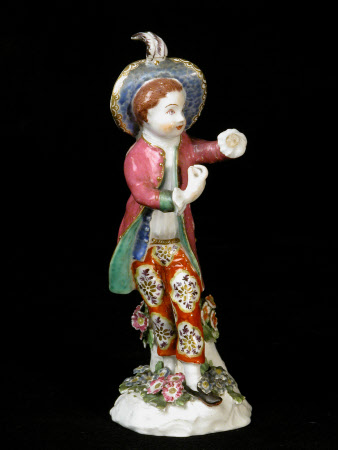Pair of dancers.
Bow Porcelain Factory (fl.c. 1748-1774)
Category
Ceramics
Date
1760 - 1776
Materials
soft paste porcelain
Measurements
155 mm (Height); 65 mm (Diameter)
Place of origin
Stratford-le-Bow
Order this imageCollection
Saltram, Devon
NT 870954
Summary
A pair of moulded porcelain figures of dancers. Made at the Bow porcelain factory, London. Decorated in polychrome enamel with gilding. The first is a girl wearing a floral dress with pink hat (damaged - probably once decorated with a feather), set on a base decorated with floral bocage. She is depicted in a dancing pose with both arms out in front. Marked with the red anchor and dagger mark for the Bow factory. The second is a boy in corresponding outfit and pose; decorated in a pink jacket with floral trousers wearing a hat with feather and posed with arms out in front. The Saltram Collection (1967): No 261T, p.59
Full description
The Bow porcelain factory was, alongside Chelsea, the first soft paste porcelain factory to be established in England. Initially founded at a site in Bow, it later moved to ‘New Canton’ east of the River Lea, then in Essex. The factory produced a porcelain that originally incorporated bone ash – a precursor to bone china. By the late 1750s, it employed around 300 workers and produced a substantial output of useful and decorative wares. Despite its size and popularity in the 1750s, the Bow factory suffered financial setbacks and was purchased by William Duesbury in 1776, owner of the Derby factory, who closed the Bow production and sent many of the moulds and tools to Derby. Although these figures were sold as pairs, the bases on both of these differ (one open, one closed) suggesting that they were originally produced separately and have been put together at a later date. .
Provenance
At Saltram by 1951 and accepted by HM Treasury in lieu of full payment of Estate Duty from the Executors of Edmund Robert Parker (1877-1951), 4th Earl of Morley
Makers and roles
Bow Porcelain Factory (fl.c. 1748-1774), manufacturer
References
The Saltram Collection (1967):, No. 261T, p.59

